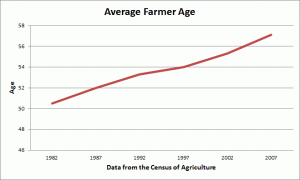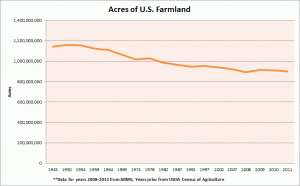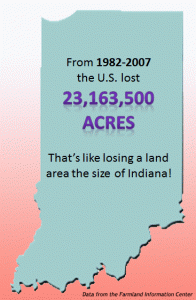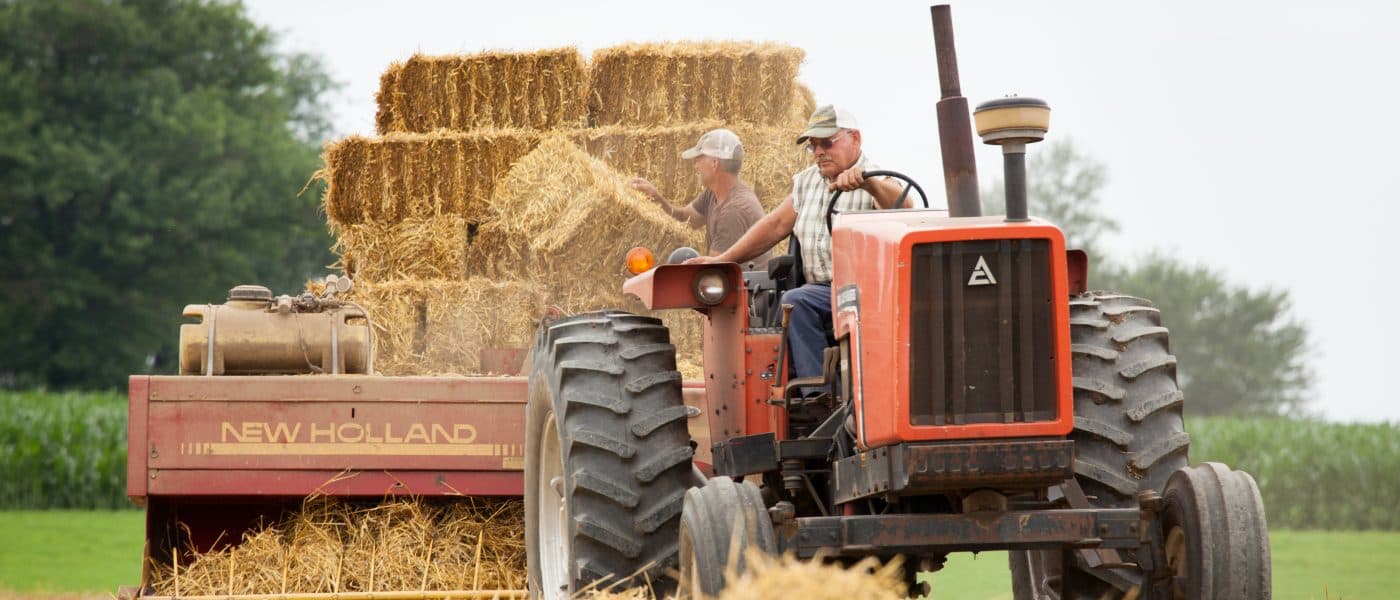March 2013
Dear Farm Aid,
I’ve been farming for five years and am looking to purchase land in my area. The problem is I can’t find anything affordable. Land goes for thousands of dollars an acre out here! Why is it so difficult to find affordable land these days?
Anna
Iowa
We wish we could say that you’re an exception to the rule, Anna, but the hard truth is that beginning farmers and ranchers across the country are facing the very same problem as you. Here at Farm Aid, land access is one of the most-requested needs sought through our Farmer Resource Network and hotline (1-800-FARM-AID and farmhelp@farmaid.org).
The availability and accessibility of land is an issue to which all of us who care about good food and farming should pay attention. America’s farming system, which depends on land first and foremost, is at a critical turning point. In the next 10 years, half of America’s farmers will retire. At the same time, our land base is shrinking at an alarming rate.
Who will farm the land? How much of it is available? Who owns it? Who can afford it? – All of these questions remain unanswered. Too often, new farmers like you are forced to navigate this painful reality alone. Let’s take some time to examine the causes of restricted land access for our country’s beginning farmers.
Aging Farmers and Land: The Numbers
More than half of U.S. farmland is managed  by farmers over age 55 and a full 30 percent of today’s farmers are 65 years or older. Beginning farmers – classified by the USDA as having fewer than 10 years farming experience – account for 22 percent of all farmers and ranchers. While significant, that share has dropped significantly in the past three decades, indicating that there are more people leaving their careers in agriculture than there are people beginning them.[1]
by farmers over age 55 and a full 30 percent of today’s farmers are 65 years or older. Beginning farmers – classified by the USDA as having fewer than 10 years farming experience – account for 22 percent of all farmers and ranchers. While significant, that share has dropped significantly in the past three decades, indicating that there are more people leaving their careers in agriculture than there are people beginning them.[1]
Many of our new farmers will not inherit land from  relatives, and most lack the capital needed to purchase land. Beginning farmers – who are more likely to engage in alternative farming practices, such as organic agriculture, diverse crop and livestock operations and more localized markets – are often pioneering business models far different than the ones dominating today’s agricultural system. And that means they find it harder to access traditional resources like credit and crop insurance that help secure land tenure.
relatives, and most lack the capital needed to purchase land. Beginning farmers – who are more likely to engage in alternative farming practices, such as organic agriculture, diverse crop and livestock operations and more localized markets – are often pioneering business models far different than the ones dominating today’s agricultural system. And that means they find it harder to access traditional resources like credit and crop insurance that help secure land tenure.
In short, a gaping hole will be left in our food system as the aging farm population retires. Despite growing interest among young people to farm, access to affordable, quality farmland is a stubborn barrier preventing many from getting started.
A Wasted Resource
The U.S. is graced with more arable land than any other country on the planet, but as a society, we’ve done a poor job stewarding it. The American Farmland Trust estimates that we lose an acre of farmland to development each minute. On the grand stage, it means we’re losing millions of acres of prime farmland each year. Between 1982 and 2007, we lost over 23 million acres of farmland across the country – an area about the size of Indiana!
It’s not only that development is increasingly butting up against farmland and driving up land prices, it’s also that we’re not using developed land wisely. While the US population grew by 30% between 1982 and 2007, the amount of developed land increased by 57%.
Speculation and the Silent Land Grab
And then there’s the darker side to this issue.
After the housing bubble burst a few years ago (and nearly tanked the U.S. economy in its wake) investors and banks started looking for new markets.[2] The hottest item they’ve landed on? You guessed it: farmland!
As farmland becomes an additional commodity for banks and investors to buy up and turn a profit with, strains on the family farmer are mounting. In the American Midwest, it is estimated that about a quarter of farmland buyers are now institutional investors seeking to hedge against inflation. This “financialization” of our land base threatens our ability to produce healthy food for everyone – here and around the globe.[3]
Land speculation can hasten the “boom and bust” cycle of farmland markets (much like speculation in food commodities has done for decades), and is a major player in the rapidly skyrocketing costs of farmland today. Farmland values in Iowa, for example, have jumped by 90 percent since 2009, now costing several thousand dollars per acre. One 80-acre parcel in Sioux County reportedly sold for $21,900 per acre in October![4]
Every minute, we lose one acre of farmland to development.
Because farmland is either a huge piece of equity or a huge cost for farmers, land prices can weigh heavily on the health of the family farm. For farmers who own their land, they enjoy it as critical collateral for operating loans that keep the farm business afloat. Tenant farmers, however, often carry a burden of higher rents and costs when land prices go up, without receiving any of the benefits. Across the country, about 30 percent of U.S. farmland is owned by landowners who do not farm the land.
Find Your Match
Luckily, it’s not all doom and gloom. As we consider the stability of our land base moving forward, the root of our entire food system, we should keep in mind the importance of helping farmers build equity and enjoy ownership of the land they farm.
We’re seeing important solutions developed at the state level. Your state of Iowa, for example, offers tax credits to retiring farmers who lease their land to beginning farmers. There is an effort underway to double the current level of tax credits offered to this effort, which would help beginning farmers compete for land that generally goes to the highest bidder. Several other states are offering loan and financing programs catered to beginning farmers.
Many states are also creating land matching and land link programs to help new farmers and established farmers to find each other. Not so unlike eHarmony or Match.com, land link programs help new farmers find land appropriate to their needs, and help retiring farmers or landowners make sure their operation will continue long into the future.
At the federal level, new financing programs like the Land Contract Guarantee Program, meant to incentivize land transfer to new farmers, and the Beginning Farmers and Rancher Development Program (BFRDP) are working to support financial and technical assistance for farmers, including land link and farm transfer programs nationwide. However, funding for these programs are in jeopardy as Congress stalls in developing a new Farm Bill.
Resources to Help
Visit Farm Aid’s Farmer Resource Network for organizations in your area that can help you find land suitable to your needs. The following resources will help you get on your way:
- Center for Rural Affairs has an extensive list of land link programs across the country.
- The National Young Farmers’ Coalition’s list of online resources for land and farming opportunities.
- The Midwest Farm Connection offers online matching for beginning farmers interested in sustainable agriculture to continue agricultural production and protect farmland in the Midwest.
- Land for Good helps new farmers secure farmland in New England. Check out their guide, Farm Succession and Transfer, Strategies for the Junior Generation [PDF link] and their resources pagefor helpful tools on land acquisition, including their online manual for their FarmLASTS Projectwith the University of Vermont.
- The Farm Service Agency’s Transition Incentives Program (TIP) Net is a tool that connects retiring landowners and beginning (including socially disadvantaged) farmers and ranchers.
Sources
1. USDA Economic Research Service. (2013) Beginning Farmers and Ranchers At A Glance: 2013 Edition. Economic Brief Number 22. January 2013.
2. National Family Farm Coalition. July 2012. Institutional Investors and the Great American Farmland Grab. Washington, D.C.
3. Kugelman, Michael. “The Global Farmland Rush.” The New York Times. February 5, 2013.http://www.nytimes.com/2013/02/06/opinion/the-global-farmland-rush.html
4. Doering, Christopher. “Farmland prices: Is the bubble about to burst?” USA Today. March 24, 2013.http://www.usatoday.com/story/money/business/2013/03/24/farm-land-prices-bubble/2013451/
Further Reading
Further Reading
- Read this Farmer Hero profile of Jeff and Annie Main to see how they’re helping ensure that farmland will be available to generations to come. “You have this ideal image of a successful farm in your mind, but then Jeff and I realized that it takes more than one lifetime to build a farm.”
- Farm Aid’s Beginning Farmers Guide is a good place to start if you’re looking for information on starting a new career in farming.


